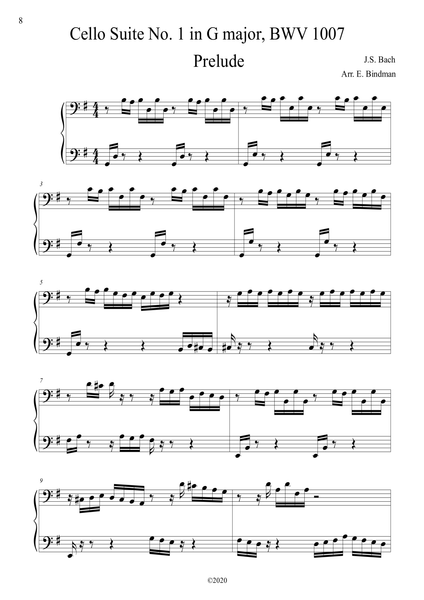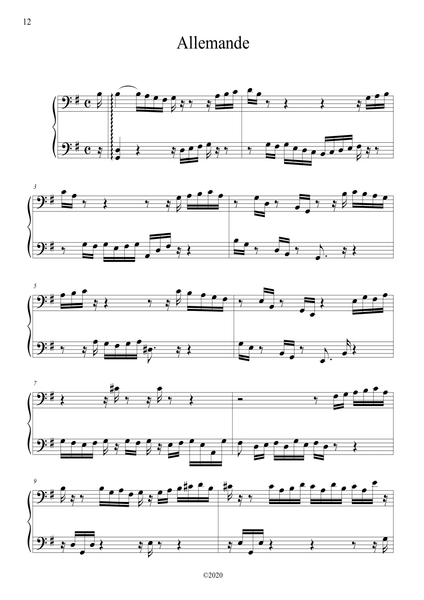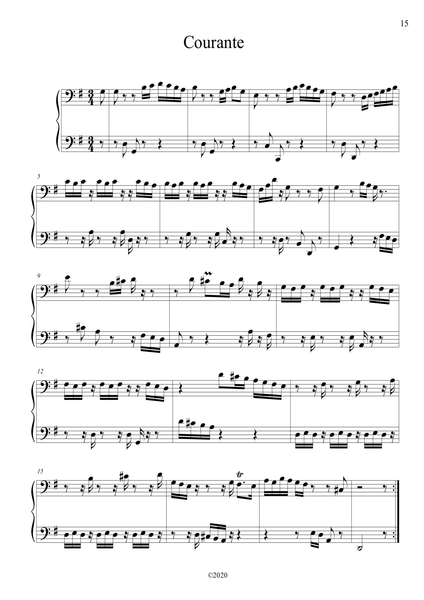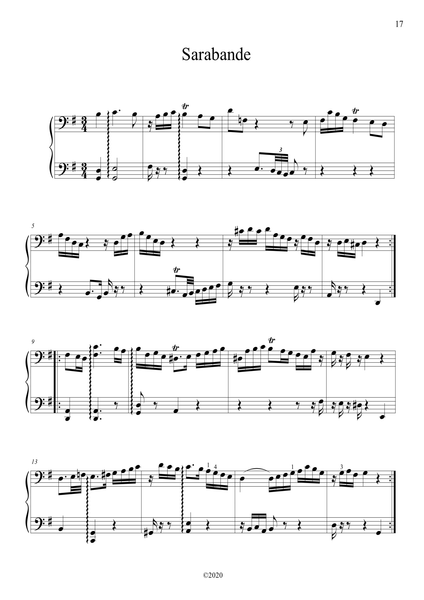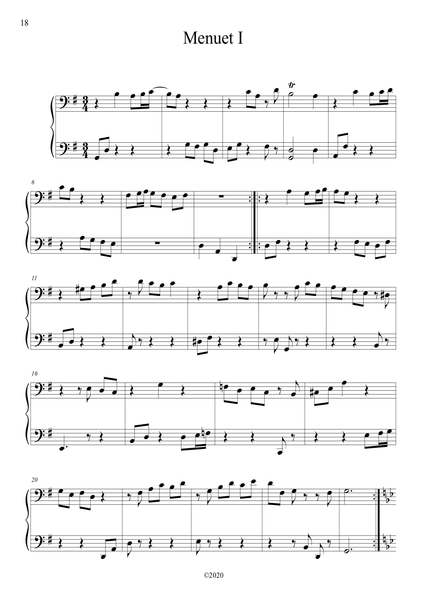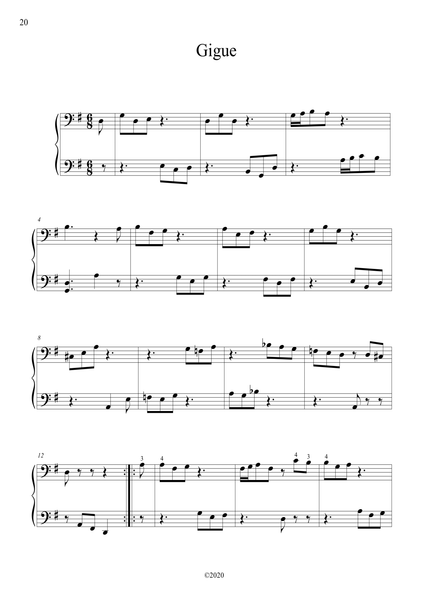J.S. Bach: Cello Suite No. 1 in G major, BWV 1007 – arranged for piano by Eleonor Bindman (GPC075)
This is the sheet music edition of a new piano arrangement of the Bach Cello Suite No. 1 in G major by Eleonor Bindman.
Solo piano
14 pages
Duration: 18:41
Audio samples
Buy, stream and download the CD here.
Suite No. 1 is well-grounded in the key of G major, starting with an open tonic chord of G, the D a fifth above, and a B a 10th above. Bach unifies this Suite by planting this chord, a compositional seed of sorts, in each of the six movements and continues to use a similar common feature in Suites 2 and 3. The calm and beneficent quality of G major coupled with the “seminal” approach created in me a strong association with growth, nature as a source and healer of all things, and the color green.
The beginning four measures of the familiar Prelude flow in 16th notes and spell out a harmonic progression of chords, just like the four incipient measures in Prelude No. 1 of The Well-Tempered Clavier, another iconic “instrumental study set” of Bach’s. However, here we are immediately faced with an element of instability within structure, the wavering BAB (or CBC) pattern, which becomes a source of variety and departure, making this Prelude longer and more interesting.
You can see the three-note fragments (BAB, GF#G etc.) descend and lead into a new bass note in m. 5 (C#, the first accidental and leading tone of D major) and then lengthen into trills in m. 6. Measures 7-8 use already established patterns and in mm. 9-10 scale-wise motion and an arpeggio bit in the dominant key of D major end the “exposition” section.
In mm. 11 and 13 diminished harmonies slightly disrupt the emotional stability but resolve promptly in mm. 12/14. Measure 15 is already familiar. Then Bach inserts the first dramatic ascent by means of a pedal point based on G in mm. 16-18 which culminates in m. 19 – a new iteration of the initial chord – only to roll back into the C# to C (mm. 20-21) bass anchoring the Dominant chord statement in m. 22. The first half of m. 22 is an interesting blend of a D7 chord with an ascending D major scale and the unexpected C# causes a naturally expressive “stretch” of time and space before the arrival at the highest D where Bach puts a fermata. He wants us to pause midway through the piece, to interrupt the hitherto perpetual motion and take a breath. I took the liberty of inserting a 16th rest here instead of a tied 16th note after the fermata as we find in the manuscripts. A rest is a more logical notation of the concept and produces less “cognitive dissonance.”
From the fermata through m. 28 the Prelude ascends and descends, occasionally stumbling into an Eb, Bb, G# and highlighting friction between flats/naturals and sharps/naturals of the same scale degrees. In mm. 29-30 Bach writes out an almost pedantic downward scale sequence before very intentionally dividing the line into two voices, one settling on A and the other moving on and above the same A for six measures. Cellists use 2 strings for these voices but a pianist has to struggle for clarity when the hands share the same key. One solution is to experiment with transposing the repeated A into a lower register, either fully or partially, as I opted to do on my recording of this transcription. In mm. 37-38 the voices move to D (dominant) and a steadily ascending chromatic scale which finally bring us back to G major for the home stretch. Measures 39-41 are now further divided into three-voice chords but, unlike the beginning, there is no wavering anymore as we reach the last chord.
A tempo commonly heard for this Prelude is around 72 per quarter. Fluctuations are possible in transitional, more improvisatory passages but the broken chords need to remain steady. The dynamic level is generally mf but any harmonic or directional changes hold potential for subtle variety. The effect of repeating the same fragment as a softer “echo” may work in some instances (I like it in mm. 8 and 20) but it’s better not to overindulge in that. And at the end, since the motion struggles upward and the energy increases, a crescendo makes sense.
The Allemande of Suite No. 1 starts with same chord as the Prelude and unfolds into an unhurried narrative with long phrases. I suggest switching hands in mm. 4/6 so that the repeated-note passages are executed with better phrasing. Measures 9 and 10 start with open chords, reminiscent of the Prelude, and I use that idea for the repeats in the recording, filling in the rhythmical gaps in mm. 1, 6, 7, 11, 12 etc., in order to create an endless stream of 16th notes, a nod to the Prelude. The tempo, dynamics and mood here should echo the Prelude as well.
This Courante is notable for very distinct and playful repeated intervals in the left hand, mostly perfect fifths. They occur throughout the entire movement, first in 8th notes and then in 16ths, conveying a light-hearted and contrasting change of pace after the first two movements and before the Sarabande. Bach is also playing around with the lower neighbor three-note figures from the Prelude here, repeating them in mm. 5/6, 11/12, inverting them in 14/15 and continuing during the second half with more fun interval play and pattern inversions. He drives the ending home with the three-note lower neighbor patterns in the right hand and a sequence of four perfect 5ths in the left. The “seed” chord here is spelled out backwards, from top to bottom, starting with the last two 16th notes of m.1. So long as the Courante is faster and lighter than the Allemande, a wide range of tempi is possible. You can try around 112 per quarter note.
The Sarabande is the most appropriate movement of Suite No. 1 for imitating the cello sound and enjoying the duration of the longer notes. The dotted rhythms with 32nd notes here are an indication that the tempo should be on the slow side even for a Sarabande, about 40 per quarter note. The first half employs straightforward harmony but the second has more variety: note the mood-altering modulation to E minor in mm. 11-12. In m. 15 I hold the D in the right hand because it’s clearly intended as a part of the upper voice.
It’s amusing to see how Bach uses the initial chord in the Menuets: very obviously in Menuet I and backwards in Menuet II (with a stray Eb), especially enhancing the contrasting minor mood by the downward motion. The presence of 16th notes implies a conservative tempo, 108 per quarter or slower. These sonorities remind me of a guitar, so I add some notes upon repeats to fill in the bass line, as is often heard in guitar transcriptions of Bach.
The Gigue of Cello Suite No. 1 needn‘t be too fast, as it has some 16th notes which need to be articulated. I think of it at about 70-72 per dotted quarter and try to imitate the “hunting horn” sound: not too long, not too short, with a focused attack on every note. Our main chord – the only chord in this movement – is hiding in the fourth measure but hunting it down is no trouble at all. Upward tension builds in mm. 28-32 before a downward broken chord ending, its momentum slowed down via a group of four 16th notes in m. 33 for a built-in ritardando.
– Eleonor Bindman







